2.Respiration– The Energy Releasing System
2. RESPIRATION– The Energy Releasing System
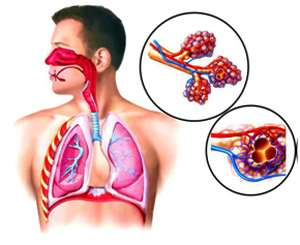
Synopsis :
- Respiration is a process by which food is broken down by release of energy.
- Respiration is also referred to as a process involving passage of air and production of body heat.
- Respiratory system is the integrated system of organs involved in the intake and exchange of oxygen and carbohydrates between an organism and the environment.
- From his early experiments Lavoisier thought that the gas liberated on heating charcoal was like fixed air.
- Lavoisier also showed that whatever it was in the atmosphere helped in burning of phosphorous.
- Lavoisier noted that the air we breathe out precipitated lime water while that after heating metal did not.
- Lavoisier also found out that something even beyond lungs occurred to produce carbon dioxide (fixed air) and body heat.
- The path way of air in our body through respiratory system- Nostrils —›
Nasal Cavity —› Pharynx —› Larynx —› Trachea —› Bronchi —› Bronchioles —› Lungs —› Alveoli. - By ‘respiratory system’ we usually mean the passages that transport air into the lungs and to the microscopic air sacs called alveoli and vice versa.
- The inhaled air passes through the nasal cavity, its temperature is brought close to that of the body and it takes up water vapour from it. Air is also filtered in the nasal cavity.
- Epiglottis, a flap like muscular valve controls movement of air and food towards the respective passages.
- When air passes over the vocal chords in larynx, it causes them to vibrate and produce sounds.
- Trachea or wind pipe channelises air to lungs and divides it into 2 bronchi- one leading to each lung.
- The bronchi divided further into smaller and smaller branches called bronchioles.
- Bronchioles finally terminate in clusters of air sacs called alveolus in the lungs which are very small and numerous.
- Gaseous exchange takes place in alveoli as blood capillaries take up oxygen and expel carbon dioxide.
- If all alveoli of our lungs are spread out, they will cover an area of nearly
160 m2 - Breathing is the process of inhaling and exhaling
- Diaphragm is a muscular tissue present at the floor of chest cavity
- When the volume of the chest cavity is increased, its internal pressure decreases and the air from the outside rushes into the lungs. This is known as internal pressure
- During expiration, the chest is lowered and moves inward and the diaphragm relaxes and assumes its dome shape. These changes increase the pressure on the lungs and; their elastic tissue contract and squeezes out air through the nose to the external atmosphere.
- Our lungs are spongy and elastic in nature covered by two membranes called pleura.
- Oxygen is carried in the blood by binding to haemoglobin which is present in the red blood cells.
- Above sea level, the concentration of oxygen is much lower about one-fifth as great as at the sea level.
- Aerobic respiration occurs in the presence of oxygen producing a lot of energy, carbon dioxide and water.
- Anaerobic respiration and fermentation occur in the absence of oxygen producing less amount of energy.
- ATP- Adenosine Tri Phosphate.
- The energy released due to the breakdown of sugar molecule is stored in ATP.
- Each ATP molecule gives 7200 calories of energy. This energy is stored in the form of phosphate bonds.
- In all the organisms glucose is oxidized in two stages. In the first stage it is converted into 2 molecules of pyruvic acid.
- In the second stage if oxygen is available, pyruvic acid is oxidized to CO2 and water releasing a lot of energy.
- If oxygen is inadequate or not available, pyruvic acid is converted into either ethanol or lactic acid and very little amount of energy.
- Accumulation of lactic acid results in muscular pain.
- Yeast grows rapidly if it is supplied with glucose in solution.
- Combustion of glucose gives carbon dioxide, water and energy.
- Animals either terrestrial or aquatic, adapted different types of respiration and different types of respiratory organs due to the habitat in which they live.
- The reasons for the development of different types of body organs are: body size, availability of water and the type of respiratory system.
- Tracheal respiratory system is seen in insects like cockroach, grasshopper, etc;
- In bronchial respiration organisms respire with the help of gills and bronchus. Eg: Fish.
- Respiration through skin is known as cutaneous respiration. Eg: Frog, Earthworm and Leeches.
- Gaseous exchange takes place in stomata of leaves. In other places on the plank like surface of roots, lenticles on stem also gaseous exchange takes place.
- Respiration and combustion differ due to the following reasons:
- Glucose must be burnt at high temperature in the laboratory to liberate energy, if it happened in our cells, all cells would be burnt.
- Once glucose starts burning we can’t stop the process easily, but living cells are able to exercise control over the sort of burning of glucose in presence of oxygen.
- Water normally stops combustion from taking place while cells contain a lot of water and respiration still goes on.
- Photosynthesis is a process of synthesis or an anabolic process which occurs in chloroplasts whereas respiration is the process of breakdown of complex food molecules or catabolic process.
- Respiration occurs in cytoplasm and mitochondria where carbohydrates are burned to produce energy.
- For a plant’s metabolism, both photosynthesis and respiration are required.
- During daytime, the rate of photosynthesis is usually higher than that of respiration while at night it is just reverse in most plants.
4 Marks Questions:
- Distinguish between
a. Inspiration and expiration b. Aerobic and Anaerobic Respiration
c. Respiration and Combustion d. Photosynthesis and Respiration
A. a. Inspiration and expiration
Sno.
Inspiration
Expiration
1.
It is an active process.
It’s a passive process.
2.
Contraction of external intercostal muscles and relaxation of internal intercostal muscles occur.
Relaxation of external intercostal muscles and contraction of internal intercostal muscles occur.
3.
Rib cages move forward and outward.
Rib cages move downward and inward.
4.
Diaphragm contracts and becomes inward.
Diaphragm relaxes and becomes original dome shaped.
5.
Increase in volume of thoracic cavity.
Decrease in volume of thoracic cavity.
6.
Air pressure in lungs is less than atmospheric pressure.
Air pressure in lungs is greater than atmospheric pressure.
7.
Intake of air into lungs.
Expulsion of air from the lungs.
b. Aerobic and Anaerobic Respiration:
Sno.
Aerobic Respiration
Anaerobic Respiration
1.
It takes place in the presence of Oxygen.
It takes place in the absence of Oxygen.
2.
Here, complete oxidation of glucose takes place.
Here, the glucose molecule is incompletely oxidised.
3.
End products are CO2 and water.
End products are either ethyl alcohol or lactic acid and water.
4.
Lot of energy is liberated (38 ATP).
Relatively small energy is liberated (2 ATP).
5.
It occurs in plant and animal cells.
Occurs in many anaerobic bacteria and human cells.
6.
C6H12O6 + 6O2 —› 6CO2 + 6H2O + 686 K.cal
C6H12O6 —› 2C2H5OH +2CO2 + 56 K.cal
c. Respiration and Combustion:
Sno.
Respiration
Combustion
1.
It occurs in living cells.
It is non-cellular.
2.
Oxidation of food materials especially glucose to Carbon dioxide and water is called respiration
When sugar burns, CO2 and water are produced and energy is released as heat. This process is called combustion.
3.
Oxidation of sugar molecules occurs at the body temperature of an organism.
Heat is to be applied for the sugar molecule to burn.
4.
The energy is released in several stages.
The energy is released at once as heat.
5.
Several intermediates are formed.
No intermediates are formed.
6.
Enzymes are required for oxidation.
Enzymes are not required for oxidation
7.
Respiration occurs in presence of water.
Combustion occurs in absence of water.
8.
It is a controlled process.
It is not a controlled process.
9.
Energy is stored as ATP in the body.
Energy is not stored and is released into the atmosphere.
d. Photosynthesis and Respiration
Sno.PhotosynthesisRespiration1.Occurs only in plants and some bacteria.Occurs in all living organisms.2.Takes place in the presence of sunlight.Takes place throughout the day.3.It occurs in chloroplast and is dependent on light.It occurs in cytoplasm and mitochondria and is independent of light.4.Raw materials are CO2 and water.Uses carbohydrates and organic substances and oxygen5.In this process light energy is fixed in the form of chemical energy and stored in carbohydrates.In this process chemical energy stored in carbohydrates burns to release energy.6.Oxygen is liberated in this process and carbon dioxide is used.Oxygen is utilized and Carbondioxide is liberated.7.Produces ATP by the use of light energy.Produces ATP by the use of oxygen.8.ATP and NADPH2 are mainly used for synthesis of organic compounds.NADPH2 and ATP are made available for cellular respiration.9.It is an anabolic process.It is a catabolic process.10.6CO2 + 12 H2O —› C6H12O6 + 6O2 +6H2OC6H12O6 + 6O2 —› 6CO2 + 6 HO + 686 K.Cal
-
What procedure did you follow to understand anaerobic respiration in your school laboratory?
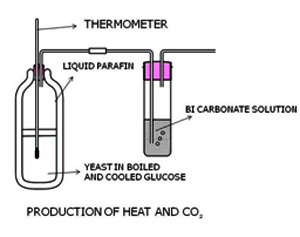
A. Aim: To prove that CO2 is released during anaerobic respiration.Apparatus: Thermos flask, splitted corks, thermometer, wash bottle, glass tubes, liquid paraffin, glucose solution, yeast cells, bicarbonate solution.
Procedure:
- Remove dissolved oxygen in the thermos flask by boiling it in thermos flask for a second and then cooling it without shaking.
- Now add some yeast to the glucose solution and fix two-holed rubber stopper to the flask.
- The supply of oxygen from the air can be cut off by pouring a 1cm layer of liquid paraffin into the mixture through the holes.
- Insert one end of the thermometer through the thermos flask. See the end of thermometer kept inside the solution.
- Arrange for any gas produced by the yeast to escape through a wash bottle containing a bicarbonate solution or lime water as shown in the fig.
- Add a few drops of diazine green [Janus green-B]solution to the yeast suspension before you pour liquid paraffin over it.
- The blue diazine green solution turns pink when oxygen is in short supply around it.
- Warm the apparatus to about 37 F in order to speed up the test.
- Keep the apparatus undisturbed for one or 2 days.
- What are your observations in combustion of sugar activity?
A. Observations in combustion of sugar:
- When sugar is heated first it chars and later burns producing flames.
- When sugar is combusted, Carbon dioxide and water are produced.
- Energy is also released in the form of heat and is released at once.
- We cannot control the combustion of sugar and also intermediate products are not formed.
- We can combust sugar in the absence of water and also enzymes are not required.
-
Due to combustion of sugar, heat energy is released into the atmosphere and we cannot store it for further use.
- What is the pathway taken by air in the respiratory system? Illustrate with a labelled diagram
A. The pathway taken by air in the respiratory system:
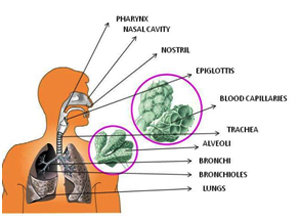
Nostrils —› Nasal Cavity —› Pharynx —› Larynx —› Trachea —› Bronchus—› Bronchioles —› Alveoli —› Blood
- Air enters the body through the nostrils.
- Air is filtered in the nasal cavities and also its temperature is brought close to that of the body.
- Pharynx is the junction of respiratory and digestive system.
- Epiglottis- a flap-like muscular valve controls movement of air and food towards their respective passages.
- Larynx is also called sound-box. It contains vocal cords. When air passes out of the lungs and over the vocal cords, it causes them to vibrate.
- This produces sounds on the basis of our speech, song, etc;
- Trachea is also called the wind pipe. It channels air to lungs.
- Trachea at its lower end divides into 2 bronchi one leading to each lung.
- The bronchi further divide into smaller and smaller branches called bronchioles.
- Bronchioles finally terminate in clusters of air sacs called alveoli in lungs which are very small and numerous.
- Gaseous exchange takes place here as blood capillaries take up oxygen and expel carbon dioxide here.
-
Blood carries oxygen to each and every cell of the body. The whole passage from nostrils to alveoli is moist and warm.
- Draw a block diagram showing events in respiration. Write what you understood about cellular respiration.
A. Events in Respiration:

c. Gas Transport by blood
Transport of oxygen from blood capillaries Exchanging oxygen from blood
d. Gaseous exchange
alveoli to body cells and return of into the cells and carbon dioxide
carbon dioxide. from cells into the blood.e. Cellular Respiration
Using oxygen in cell processes to
produce carbon dioxide and water,
releasing energy to be used for life process.Cellular Respiration:
- All living organisms must carry out cellular respiration.
- During respiration, energy is produced when the glucose or fatty acids are oxidised in the cells. As this process occurs in the cells, this is called cellular respiration.
- It can be in the presence of oxygen that is aerobic respiration or in the absence of oxygen that is anaerobic respiration (fermentation).
- Cellular respiration in prokaryotic cells like that of bacteria occurs within the cytoplasm.
- In Eukaryotic cells, cytoplasm and mitochondria are the site of cellular respiration.
- The complete breakdown of sugar molecule with the release of all its available energy involves a series of chemical reactions.
- The energy released in cellular respiration is stored in a special compound called ATP.
-
ATP is utilised for carrying out other functions in the cell.
-
How do you appreciate the mechanism of respiration in our body?
Ans.- Respiration is essential for life because it provides energy for carrying out all the life processes which are necessary to keep the organism alive.
- The energy that is obtained from respiration is used to build the organism through cell growth and reproduction as well as cell repair.
- All systems in a living being need energy to survive. Energy is defined as the ability to do work. So without respiration we would not have any energy to perform necessary day-to-day functions.
- Respiration helps to expel the toxic co2 out of the cells. This co2 will be utilised by plants for photosynthesis.
- The respiratory system goes into operation from the movement of our birth to death.
-
During exhalation the vocal cords in the larynx vibrate to produce sounds.
- Write an experiment to observe changes during combustion of sugar.

Aim: To observe changes during combustion of sugars.
Apparatus: wooden stand, test tubes, rubber topper, delivery tube, glucose or sucrose powder and lime water.
Procedure:
- Take a small amount of glucose in a test tube.
- Arrange the apparatus as shown in figure.
- Heat the test tube with glucose powder over a flame.
- Go on heating till the glucose catches fire.
Observations:
- When glucose burns, co2 and H2o are produced and energy is released as heat.
- Glucose must be burnt at high temperature in the lab to liberate energy.
- Once the glucose starts burning we cannot stop the process easily.
- Combustion can be stopped by adding water to the glucose powder.
- The co2 released changes the lime water into milky white.
Conclusions:
- From this experiment we can conclude that combustion of glucose produces co2, H2o and energy is released as heat.
-
The co2 released changes the lime water into milky white
- How can you prove that co2 is evolved during respiration?
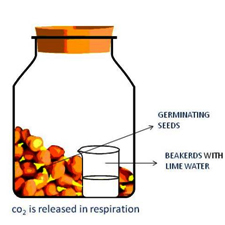
Aim: To prove that Co2 is released during aerobic respiration.
Apparatus: Two plastic or glass bottles, germinating seeds, dry seeds, two small injection bottles or beakers with lime water
Procedure:
- Take a handful of moong seeds and soak a day before experiment.
- Keep the soaked seeds in a cloth pouch and place it in a corner of class room.
- Next day collect the germinating seeds and keep it in glass bottle around 200ml capacity.
- Take a small beaker with 3/4 lime water, insert in the bottle carefully and close the bottle tightly.
- Make a similar set with dry seeds. Keep both bottles undisturbed for one or two days.
- During this time observe the colour of lime water in both bottles.
Observation: After two days it can be observed that lime water in the bottle containing germinating seeds turns into milky white precipitate.
Result: It indicates that germinating seeds liberated co2 which turns lime water into milky white precipitate.
- How can we show that heat is liberated during respiration?

Aim: To prove that heat is evolved during respiration.
Apparatus: Thermos flasks, two thermometers, rubber corks, dry seeds, germinating seeds.
Procedure:
- Take a handful of moong seeds and soak a day before experiment.
- Keep the soaked seeds in a cloth pouch and place it in a corner of class room.
- Next day collect the germinating seeds and keep it in glass bottle around 200ml capacity.
- Make a similar set with dry seeds. Keep both bottles undisturbed for one or two days.
- Arrange thermometers through one holed cork, in such a way that the bulb of the thermo meter should dip in the germinating seeds and dry seeds.
- Record the initial temperature in both flasks and record it for every 2 hours for at least 24 hours.
Observation: Constant increase in the temperature is observed in the thermometer placed in germinating seeds.
Result: Hence, it is proved that germinating seeds respire and liberate heat which is responsible for increase in temperature in the thermo meter."
- What is role of epiglottis and diaphragm in respiration?
Ans. EPIGLOTTIS:
- It is flap like muscular valve that controls movement of air and food towards their respective passages.
- It serves as protection to our wind pipe. It stops food and liquid from going into air way.
- It allows air pass through the larynx and the respiratory system.
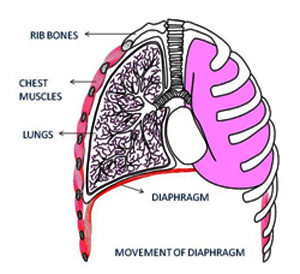
DIAPHRAGM:
- It is a dome shaped sheet of muscle that separates the chest from the abdomen.
- During inhalation it contracts and moves in the inferior direction, thus enlarging the volume of the thoracic cavity.
- This reduces the pressure in the lungs and air enters into lungs.
-
During exhalation the diaphragm relaxes and assumes its dome shape. This change increases the pressure on the lungs and squeezes the air out through the nose to the external atmosphere.
-
After a vigorous exercise or work we feel pain in the muscles. What is the relationship between pain and respiration?
Ans.- We obtain energy by aerobic respiration.
- But anaerobic respiration takes place in our muscles.
- During vigorous exercise O2 gets used up faster in the muscles that can be supplied by the blood.
- When anaerobic respiration takes place in human muscles, glucose is converted into lactic acid with the release of a small amount of energy.
- The anaerobic respiration by muscles brings about partial breakdown of glucose to form lactic acid.
-
The accumulation of lactic acid in the muscles causes muscular pains or cramps.
- If you have a chance to meet pulmonologist, what questions you clarify about pulmonary respiration?
Ans.- What is the cause for lung cancer?
- What type of diagnostic tests will be performed to assess the function of lungs?
- What is asthma?
- How can asthma be cured?
- What is pneumonia? How is it caused?
- What is chronic obstructive pulmonary disease?
- What is tuberculosis? Can it be cured permanently?
- What is pulmonary edema? How does it occur?
- What is the organism that causes acute bronchitis?
- Can all the diseases of lungs be cured permanently?
Two Mark Questions
-
State two similarities between aerobic and anaerobic respiration?
Ans.- Both aerobic and anaerobic respirations release energy by breaking down glucose.
- The energy produced by these processes is used to carry out various functions in our body.
-
Both respirations take place in a cell.
-
How does choking of wind pipe is caused by food?
Ans.- Trachea [wind pipe] is covered by epiglottis, so when a person swallows food, it doesn’t go into the trachea.
- If food enters the trachea, it can block it completely and cause a person to choke to death.
- If the food goes down the trachea, it can lodge in the main pipe and cause suffocation.
-
If food enters the trachea, it generally causes a person to cough forcefully enough to remove the food.
-
Why does the rate of breathing increase while walking uphill at a normal pace in mountains? Give two reasons.
Ans. The rate of breathing increases while walking uphill at a normal pace in Mountains because of the following reasons -- As we go up the hill above sea level, the concentrations of O2 is greatly reduced. So we have to breathe more to get required amount of O2.
- While walking the uphill, a lot of oxygen is used by our body to release energy from glucose.
- This leads to lack of O2 in the cells.
-
Hence, to increase the amount of O2 intake there is an increase in breathing rate during walking uphill.
- Plants photosynthesize during day time and respire during night. Do you agree? Why? Why not?
Ans.- No, I don’t agree with this statement. Plants photosynthesize during day time only and respire during the day and night as well.
- During day time when photosynthesis occurs, O2 is produced. The leaves use some of this O2 for respiration and the rest diffuses into air.
- During day time CO2 produced by respiration is all used up in photosynthesis by leaves.
-
At night time no photosynthesis occurs and oxygen diffuses into leaves to carry out respiration.
-
Why does a deep sea driver carry O2 on his/ her back?
Ans.- O2 is present in dissolved state in water.
- Human beings don’t have gills like the fish which can extract dissolved O2 from water and utilise it for breathing.
- Moreover as we go deep down in water, the O2 level decreases.
-
So, a deep driver carries an O2 gas cylinder for breathing when he/she goes deep under the sea water.
-
Where will the release of energy from glucose in respiration take place? Mala writes lungs, while Jaya writes muscles. Who is correct and why?
Ans.- Respiration is the process of releasing energy from the breakdown
- of glucose.
- Respiration takes place in every cell, all the time and all cells need to
- respire in order to produce the energy that they require.
-
So, Jaya is correct. The energy is released from muscles during respiration. Only gaseous exchange takes place in lungs.
-
How are alveoli designed to maximise the exchange of gases?
Ans. The human lungs have been designed to maximise the exchange of gases as follows:- There are millions of alveoli in lungs.
- The presence of millions of alveoli in the lungs provides a very large area for the exchange of gases.
-
Availability of large surface area maximises the exchange of gases.
- What happens if the diaphragm is not there in the body?
- If diaphragm is not there in the body, we would not be able to breathe.
- All the breathing movements will stop.
- It is the major muscle of respiration that separates the thoracic and abdominal cavities.
- The body is dependent on diaphragm for normal respiratory function; in its absence we cannot do anything.
One Mark Questions
-
What is respiration?
Ans. It is the process by which food is broken down for release of energy.
-
In Latin what does the respiration mean?
Ans. It means “to breath”.
-
Who did comprehensive work on properties of gases, their exchange and respiration?
Ans. Lavoisier and Priestley did the comprehensive work on properties of gases and their exchanage and respiration.
-
What was the gas liberated on heating powdered charcoal in a bell jar?
Ans. It was fixed air. In those days CO2 was known as fixed air.
-
According to Lavoisier what was produced by combustion of charcoal?
Ans. CO2 was produced
-
What is vitiated air?
Ans. It is term used to show air from which the component needed for burning had been removed.
-
Which gas according to Lavoisier is respirable air?
Ans. Oxygen.
-
What happens when air passes from nostril to alveolus?
Ans.- Air is filtered in nasal cavity by mucus lining and the hairs growing from its sides remove some of the tiny particles of dirt in the air.
-
The temperature of the air is brought close to that of the body.
-
What is the function of Epiglottis?
Ans. It controls the movement of air and food towards their respective passages.
-
Where does gaseous exchange take place?
Ans. Gaseous exchange takes place in tiny air sacs of lungs called ‘alveoli’.
-
What is breathing?
Ans.- It is the process of inhaling and exhaling.
-
The mechanism by which organisms obtain O2 from the environment and release CO2 is called ‘breathing’.
-
What is inspiration or inhalation?
Ans. Entry of air into lungs from outside is inspiration.
-
What is expiration or exhalation?
Ans. It is the pushing out air from lungs tao outside.
-
What are pleura?
Ans. Pleura are the two membranes that protect the lungs from injury.
-
What is cellular respiration?
Ans. Oxidation of glucose or fatty acids takes place in the cells releasing energy. Hence this process is known as “cellular respiration”.
-
What is aerobic respiration?
Ans. Oxidation of glucose in presence of oxygen is called’aerobic respiration’.
-
What is anaerobic respiration?
Oxidation of glucose in absence of oxygen is called ‘anaerobic respiration’.
-
What is glycolysis?
Ans. It is the breakdown of glucose molecules into two molecules of 3 carbon compound called pyruvic acid or pyruvate releasing energy.
-
What is the fate of pyruvate in the absence of oxygen in plants?
Ans. In the absence of oxygen pyruvate will be converted to ethanol,CO2 and water releasing energy in plants.
-
What is the fate of pyruvate in the absence of oxygen in animals?
Ans. In the absence of oxygen, pyruvate will be converted to lactic acid releasing small amount of energy in animals.
-
What is main reason for feeling pain in muscles after strenuous exercise?
Ans. Due to the anaerobic respiration in muscles large amounts of lactic acid accumulates and this results in muscular pain.
-
What is fermentation?
Ans. In the absence of oxygen, yeast cells convert pyruvic acid to ethanol. This process is called ‘fermentation’.
-
What is combustion?
Ans. Combustion is a process in which heat is evolved when organic molecules [sugar] are burnt, CO2 and H2O are released.
-
What is the full form of ATP? How is it formed?
Ans.- ATP stands for adenosine triphosphate.
-
The energy released during respiration process is used to make an ATP molecule from ADP and inorganic phosphate [P].
-
What is use of ATP?
Ans.- ATP is the energy currency for most cellular process.
-
ATP is used to supply energy in the cells for the carrying all the metabolic processes.
-
What are the substances that are used for the production of energy in all living organisms? Or what are respiratory substrates?
Ans. Glucose and fatty acids are used for the production of energy.The substances which are oxydised to liberate energy are called ‘Respiratory substrates’.
-
Where energy is stored in ATP?
Ans. Energy is stored in the terminal phosphate bond in ATP which is having three phosphates attached to a molecule of Adenosine.
-
What are the power houses of the cell?
Ans. Mitochondria are the power houses of the cell.
-
What are the end products of aerobic respiration?
Ans. CO2 and H2O are the end products of aerobic respiration.
-
Write an equation for aerobic respiration?
C6H12O6 +6O2 —› 6CO2 + 6H2O +686 Kcal.
-
What are the sites of respiration?
Ans. Mitochondria are the sites of respiration.
-
What are the three stages present in complete oxidation of glucose molecule?
Ans. The three stages are: 1.Glycolysis 2.Krebs cycle and 3.Electron Transport System [ETS]
-
Why the rate of breathing in aquatic organisms is much faster than terrestrial organisms?
Ans. The amount of dissolved O2 is low as compared to the amount of O2 in air, therefore the rate of breathing in aquatic animals is much faster than in terrestrial animals.
-
Name the substance whose build up in the muscles during vigorous physical exercise may cause cramps?
Ans. Lactic acid.
-
How trachea is prevented from collapsing?
Ans. The walls of the trachea are supported by several ‘C’ shaped cartilaginous rings. They prevent the trachea from collapsing and closing.
-
What is the composition of inhaled air?
Ans. Inhaled air contains 21% of O2, 0.03% of CO2 and 79% of N2.
-
In which kind of respiration more energy is released?
Ans. In aerobic respiration more energy around 686 Kcal is released as against 58 Kcal in anaerobic respiration.
-
Why we are advised not to talk while eating food?
Ans. We are advised so because while eating some food particles might enter the wind pipe which can lead to choking.













